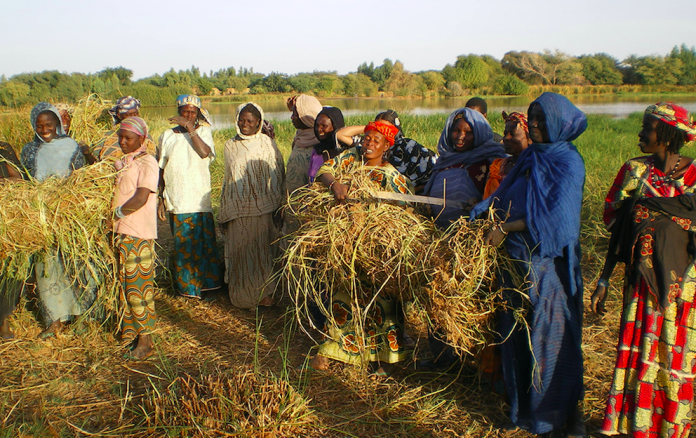Susan Canney, Director of the Mali Elephant Project, WILD Foundation & International Conservation Fund Canada, discusses governance, management and the human dimension of the human-elephant coexistence
The commons are the things we all share and need to survive and prosper. In an age of increasing threat to the Earth’s atmosphere, freshwater, oceans and the web of life, we should be paying more attention to commons management.
“Therein is the tragedy. Each man is locked into a system that compels him to increase his herd without limit – in a world that is limited. Ruin is the destination toward which all men rush, each pursuing his own best interest”. Garrett Hardin
The problem of shared resources
In 1968, Garrett Hardin postulated that humans were doomed to suboptimal outcomes, because when left to their own devices, they compete with each other for resources leading to over-consumption and the exhaustion of the resource base. He, and many others, argued that the solutions to this “tragedy of the commons” were either privatisation of a resource, or government control and top-down regulation.
There is, however, a third way. Decades of research have demonstrated that local communities have the capacity to avoid this “tragedy” through the formation of institutions that are collectively designed, monitored, and enforced. This article shows how the Mali Elephant Project (MEP) used such an approach for human-elephant coexistence.
The last article in this series described how MEP intervention on the ground began at Lake Banzena. As the only late dry-season water accessible to elephants, and threatened by the influx of growing cattle herds, it was the top priority for action. Detailed socio-economic studies of the users of the lake had revealed several surprises.
Contrary to expectations, 96% of the cattle using the lake were not local but belonged to distant wealthy urbanites; and there was heavy over-exploitation of the area’s natural resources by urban commercial interests resulting in environmental degradation. The second finding was that although individual ethnicities had systems to manage their natural resources sustainably, each was reluctant to respect the systems of another. The result was a “tragedy of the commons” because the shared resources of water, pasture, forests and game were over-exploited by individuals acting in their own self-interest, contrary to the common good.
Developing a shared understanding of the problem
The MEP convened a meeting that was open to all to share the study’s findings with the local communities. The discussion focused on the survey findings and how they related to daily life and the challenges faced by the local people; before moving on to the elephants and how people experienced them in their lives. All perspectives were encouraged and welcomed to build a shared understanding of the situation that created a sense of unity.
This was the crucial first step before moving on to discuss potential solutions, and the conditions that had to be met for such solutions to work. Any resource management arrangements needed to be transparent, inclusive and equitable to be respected by all, or they would not be sustainable into the future; and any rules also needed a means of monitoring and enforcement.
Generating solutions
Their solution was based on traditional governance systems in which a committee of elders, deemed to be expert in resource management, was elected with representation from all social groups. This committee established the rules of resource use, including the protection of elephant habitat and the migration route. The youth were recruited into teams of community “ecoguards” who would patrol to detect non-compliance, and who could call on government foresters for help in enforcement if required. The community first publicly discussed and identified the qualities required to be an ecoguard and then selected individuals with those qualities. The ecoguards also conducted resource protection and regeneration activities such as building fire-breaks and planting trees, trained by government foresters or other local specialists where necessary.
These systems provided the missing feedback relationship required to regulate and govern resource use and protect elephant habitat.
Legislation provides the “enabling” environment
Key to this approach was the enabling environment provided by Malian decentralisation legislation. This has transferred land and natural resource management responsibilities from central government to local governments and communities; who can enshrine their rules of resource management in local and commune-level legal “conventions”. It demonstrates how a broad legal framework (decentralisation) can be drafted so as to encourage adaptation to local conditions and local self-reliance. The largely illiterate rural communities did, however, need help and the MEP provided support by facilitating the process and helping to draft the required conventions.
As a result of this community natural resource governance, more pasture and forest products were available and close by, particularly during the dry season. During the first year the Banzena communities had protected over 90,000 hectares of pasture from fire and were able to sell hay and access rights, charging large commercial herds (per head) for access to water and pasture. Revenues were shared equally between the management committee, the eco-guards and the women. Their livestock proved to be healthier, worth more at market, and produced more milk and young. Subsequently the project facilitated the establishment of women’s associations (see photo) to develop small income-generating schemes that prospered from the increasingly abundant natural products but were designed to respect the limits of the ecosystem as enshrined in the community resource management conventions. These reinforced the incentives for innovation and wise resource management.
Perhaps the greatest benefit was that local communities were empowered to take the decisions themselves, doing what they already knew how to do, but within a governance framework that allowed them to prevent over-exploitation and destruction, by outsiders, of habitat and resources that supported their own livelihoods. When other communities saw the impact, they requested help to do the same thing.
Unforeseen benefits
Communities that were socially cohesive were able to implement these systems very readily and rapidly draw tangible benefits. Communities with discord needed much more support, but if that support was sustained the collective management of natural resources improved community relations substantially. As one ecoguard said “when you sit round the fire talking, having spent all day working together, you realise we all have the same problems”.
Canney, S.M. (2021) Making Space for Nature: Elephant Conservation in Mali as a Case Study in Sustainability. Environment: Science and Policy for Sustainable Development, 63:2, 4-15, DOI:10.1080/00139157.2021.1871292
Ecosystem-wide elephant conservation in the Gourma of Mali through governance that improves local livelihoods in synergy with support to government plans and enforcement strategies project has received funding from the European Union’s Development Fund under the Grant Agreement no. EDF/2018/401-337.
Please note: This is a commercial profile












